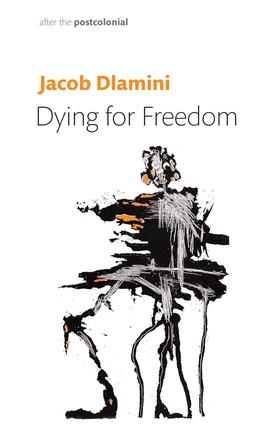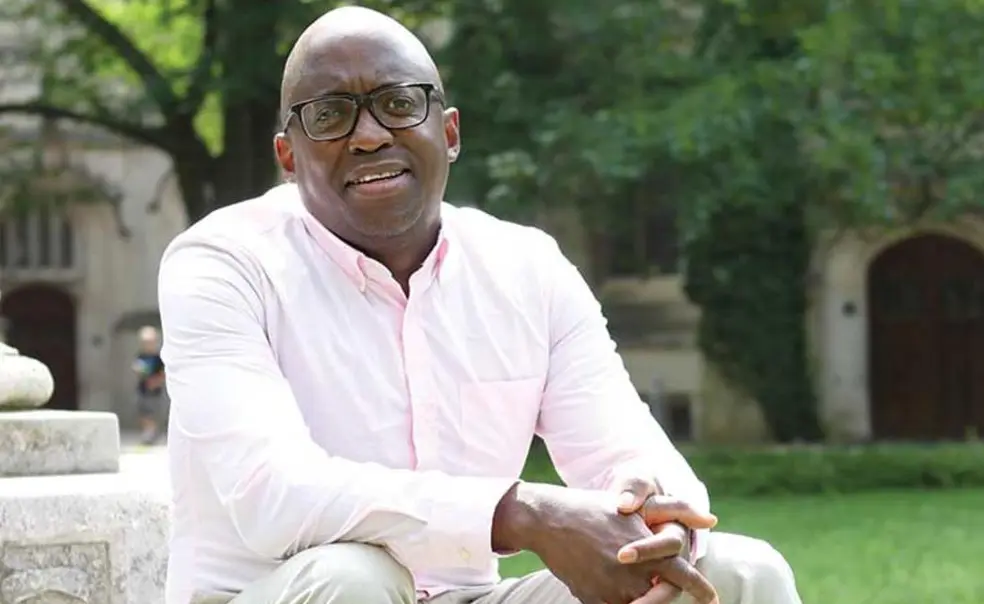Jacob Dlamini Explores Political Martyrdom in South Africa
The book: What happens when death is the marker of a person’s commitment to freedom? That’s the question at the heart of Jacob Dlamini’s book Dying for Freedom (Polity), which looks at the liberation struggle in South Africa. He examines archival evidence highlighting a prevailing narrative, that developed over time, in which death became the answer to overcoming political struggles. Anything less left others to question how seriously people were invested in the cause. Dlamini offers readers a different look at the cost of struggle against apartheid.

The author: Jacob Dlamini is director of Princeton’s Program in African Studies and an associate professor of history. As a historian of Africa, his research interests include precolonial, colonial, and postcolonial African history. He’s also a qualified field guide with interests in comparative and global histories of conservation and national parks.
Excerpt:
On December 19, 1906, five men appeared before a commission set up by Henry McCallum, governor of Natal, to examine the colony’s policies towards Africans. Four of the men were auxiliaries in the colonial army and had recently participated in Natal’s defeat of the Bhambatha rebellion, the last major attempt by amaZulu to resist British rule in southern Africa. McCallum sought to use the commission to understand the causes of the revolt. Socwatsha, one of the five, blamed Natal’s recent imposition of a poll tax on African men for the uprising, saying the one-pound tariff had caused widespread resentment, sundered families, and pitted young men against their elders. Socwatsha said these young men were so angry with their seniors – whom they accused of capitulating to the colonial government – that they had taken to exclaiming, “Happy are those who have already fought and are now dead.” Jobongo, another of the five, said colonial interference in domestic African matters had added to the onus placed on Africans by the new toll. “By reason of the burden,” Jobongo reported, “people were in the habit of saying, ‘Happy are those who are dead’.”
Socwatsha and Jobongo were loyal colonial subjects. As levies in Natal’s army, they had helped Europeans destroy indigenous political autonomy in southern Africa. But, as Africans, they were not exempt from the exactions of the colonial state; they too had to pay the tax and could see first-hand the reduction of amaZulu to penury. As patriarchs, they could see also what they took to be the adverse effect of European rule on gender and intergenerational relations among amaZulu. That is why, like many of the 5,500 Africans who took part in the commission’s eight-month-long proceedings, Socwatsha and Jobongo lamented the fate of amaZulu.
For Socwatsha’s disgruntled young men and for the people whose bitterness Jobongo claimed to channel, death was better than the indignity that defined Zulu life under colonialism. Compared to life under white rule, death was liberty for the thousands that had already perished in the resistance against Europeans. The dead were happy because they had been spared the sight of homesteads reduced to destitution. Lucky were the dead for they did not have to witness amaZulu’s loss of sovereignty or suffer the confiscation of ancestral lands. Death had in effect saved the departed from the shame of living under European rule.
This invocation of the face-saving power of death in spite of dishonor was no isolated sentiment; it was the expression of an ethos found in a range of historical contexts across time. From the ancient to the modern world, political actors have thought in complex ways about the cultural, religious, and political significance of death; and some have done so in a manner that counterposed death not to life but to freedom. As Seneca, the Roman Stoic philosopher who gave us one of the first treatises on death, put it: “Those who have learnt how to die have unlearnt how to be slaves. It is a power above, and beyond, all other powers.” Seneca said no enemy and no weapon could overcome one’s “contempt of death.” Take away your fear of death, show nothing but disdain for death and you would have, Seneca argued, a “doorway of freedom.”
From American colonist Patrick Henry beseeching his colleagues in 1775 to “Give me liberty, or give me death;” residents of Paris in 1793 daubing their walls with the slogan “Unity . . . Liberty, Equality, Fraternity or Death;” revolutionaries in Haiti saying in 1793 that they preferred a “thousand deaths” to the return of slavery to the island; Greek nationalists coining in 1814 the mantra Eleftheria i thanatos! (Freedom or Death!), that still serves as Greece’s national motto, to Emmeline Pankhurst telling a US audience in 1913 that suffragettes would force those opposed to the emancipation of women “to choose between giving us freedom or giving us death,” actors in diverse places have at different times endeavored to harness death for instrumental purposes. Rather than fear death as an inevitability over which they had no control, these men and women have found in it a vital force capable of serving political ends. They have found in death the very means through which to give liberty, understood here as the right to personal or collective self-determination, its meaning.
Dying for Freedom: Political Martyrdom in South Africa is about death and the anti-apartheid struggle. The book examines the idea, best expressed by antiapartheid activist Steve Biko, that one’s method of death could be a “politicizing thing.” It explores the implications of this political investment in death for how we think about betrayal, contingency, dignity, honor, and sacrifice in struggles for freedom. The book is, in short, about the political uses of death in the fight for freedom in South Africa. What happens when death becomes the absolute marker of one’s devotion to autonomy so that, as Biko said, you are either free or dead? Or when a “liberty or death” code governs struggles for liberation? What happens when the opposite of freedom is not unfreedom but death, not slavery but mortality? How are we to think of the right to life when dignity and honor might be more important than life itself? Or when individuals see death as the only shield against dishonor?
Dying for Freedom explores these questions by drawing on evidence from South Africa to show how conflicting notions of sacrifice marked campaigns for racial equality in that country, and how this led to a veneration of mortality as proof of the will to freedom. The book argues that this investment in death encouraged a masculinist style of politics in which activists understood fighting for emancipation as a struggle for manhood. Months before his death, Biko knocked out one of his police interrogators with a punch. As Biko explained afterwards, the idea was to throw the interrogator off his script and to have him hit back – “like a man,” Biko said. Biko was not unique in this regard. As chapter one shows, Nelson Mandela himself saw South Africa’s struggle as a fight for the assertion of black manhood. This masculinist politics, CelesteMarie Bernier reminds us from another context, has made it hard for scholars to identify a “black female heroic tradition” in freedom struggles involving peoples of African descent.
In South Africa, political investment in death generated a notion of sacrifice so absolute that anything less than death was rendered suspect. In a world rife with betrayal, which is what the anti-apartheid movement was for more than three decades, evading arrest, surviving an ambush, coming through torture, or completing your sentence for a political offence were grounds for suspicion and not for celebration that a comrade had lived to fight another day. In 2013, a former anti-apartheid insurgent named Archie Abrahams told me he knew that one of his comrades, a man called Cyril Raymonds, was a double agent when Raymonds could not explain to Abrahams how he had survived an attack in 1983 by an apartheid death squad. The attackers had killed two of Raymonds’ comrades. Abrahams wanted to know essentially why Raymonds had not died along with his two comrades. This use of death to measure loyalty created a world in which contingency did not exist, where no one got lucky.
Abrahams’ and his comrades’ reverence for death also built a hierarchy in which some deaths were worthier than others; it inspired a necropolitics defined by the “subjugation of life to the power of death.” In Abrahams’s world, insurgents never suffered doubt. Once committed to the cause of freedom, they never wavered. They fought to the bitter end. Only a freedom fighter was worthy of a heroic death; only spectacular acts of resistance deserved recognition; not for South Africa the weapons of the weak; not for the Struggle with a capital S the evasion, the foot-dragging, and the silent protest – even though these were, in fact, the more common forms of resistance against apartheid. Where activists acknowledged these everyday forms of resistance, they folded them into the heroic story of a unified struggle so that all resistance became one.
Excerpted from Dying for Freedom by Jacob Dlamini. Copyright © 2024 by Polity. Reprinted by permission.
Review:
“In this clear-eyed book Jacob Dlamini explores the roots of anti-apartheid passion, showing how activists made their commitment into a matter of life and death. At once sweeping and intimate, this profound work of history allows us to look again at martyrdom: as a political purpose that shaped people’s vocations, as an orientation around which a movement cohered, as a tragedy that deprived families and communities of much-loved people. This little book is full of profound insight, and I hope that it will lend to its readers a new understanding of how much the struggle against apartheid cost.” — Derek Peterson, University of Michigan











No responses yet